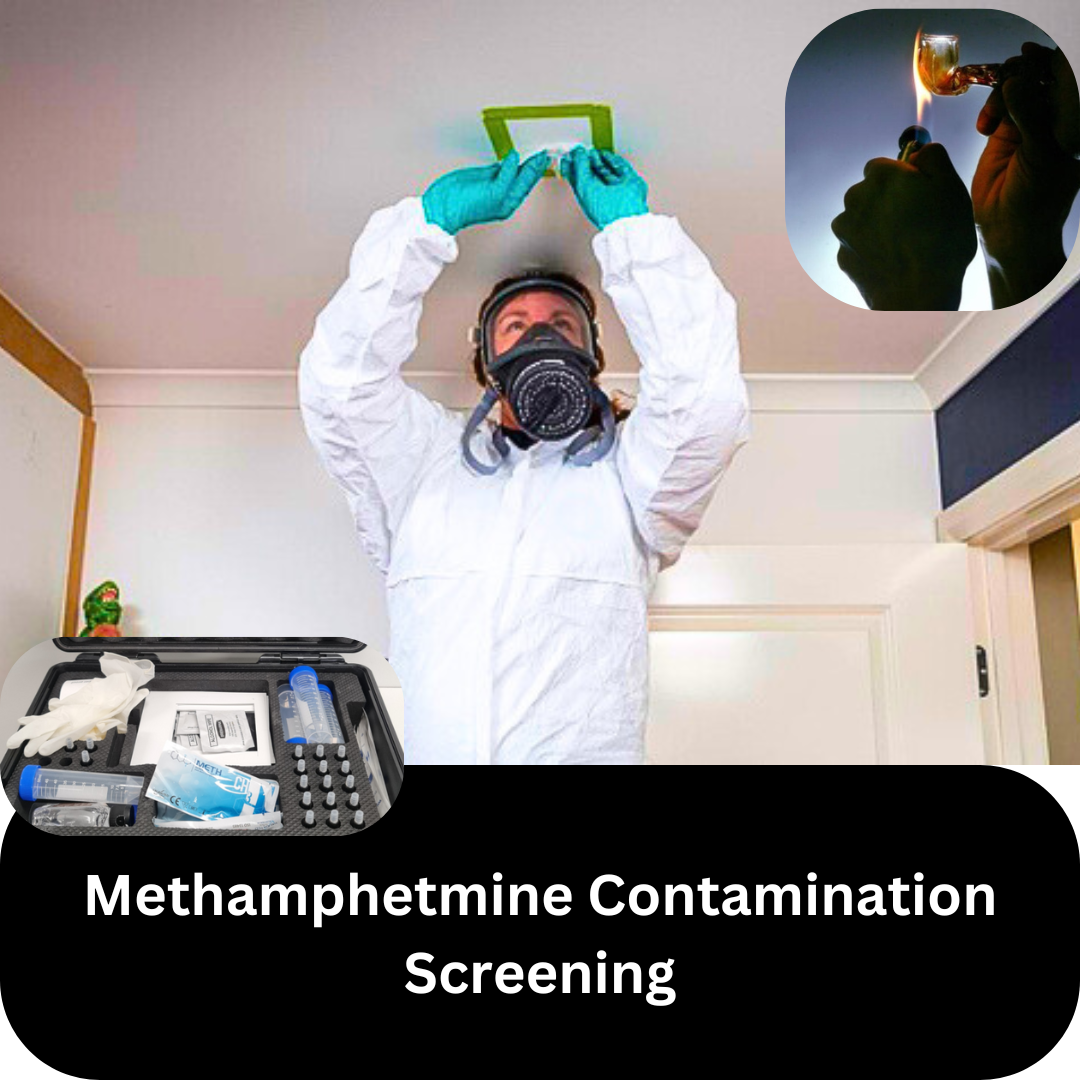
Methamphetamine Contamination Screening
Methamphetamine Contamination: A Hidden Danger in Your Home

Methamphetamine, a highly addictive stimulant, leaves behind a toxic residue that can linger in homes long after the drug has been used or manufactured. This invisible danger poses significant health risks to occupants and can significantly impact property values.
Beyond the immediate effects of meth use, the residual contamination can have far-reaching consequences. Methamphetamine residue can infiltrate various surfaces throughout the home, including.
- walls.
- floors.
- ceilings.
- furniture
- carpets.
These surfaces become reservoirs for toxic fumes that gradually seep into the air, exposing occupants to a range of health hazards.
- Respiratory issues are a common concern, with individuals experiencing difficulty breathing, chronic coughing, wheezing, and even more serious respiratory complications.
- Skin irritation is another prevalent issue, manifesting as constant itching, rashes, and skin sores.
- Neurological impacts are also a significant concern, with headaches, dizziness, difficulty concentrating, and even more serious neurological issues arising from long-term exposure.
- Eye irritation, characterized by redness, watering, and blurred vision, is a common symptom.
The health risks extend beyond general populations. Pregnant women and their unborn children are particularly vulnerable. Exposure to meth residue can increase the risk of

- Premature birth.
- Low birth weight.
- Placental abruption.
- Fetal growth restriction.
- Severe developmental issues in the unborn child, including learning disabilities, behavioral problems, and attention-deficit/hyperactivity disorder (ADHD).
Individuals with compromised immune systems, such as those undergoing chemotherapy or living with HIV/AIDS, are also at increased risk of experiencing more severe health effects from meth exposure.
Children are particularly vulnerable due to their smaller size and developing bodies, which may make them more susceptible to the harmful effects of meth residue.
Impact on Property Value: A Hidden Cost

The presence of meth contamination can significantly devalue a property, making it difficult to sell or rent. Potential buyers and tenants may be wary of purchasing or renting a property with a history of meth use, even after remediation.
Furthermore, cleaning up meth contamination is a complex and costly process. Specialized techniques and materials are often required to effectively remove residue from surfaces and ensure the property is safe for habitation. The cost of remediation can range from upwards of $5,000 to more than $10,000, depending on the extent of contamination. In severe cases, such as clandestine meth labs, the damage can be extensive, requiring the removal of drywall, insulation, and even flooring.

Even seemingly effective cleanup attempts, such as painting over contaminated surfaces with water-based paint, may be insufficient. Methamphetamine residue can seep through improperly applied paint, continuing to release harmful fumes and posing ongoing health risks to occupants.
Signs of Methamphetamine Contamination

Chemical burns: On surfaces like sinks, countertops, and floors from the corrosive chemicals used in the meth-making process.

Unusual staining: Yellowish-brown stains on walls, ceilings, and fixtures caused by chemical reactions and residue.

Holes in walls or ceilings: From attempts to conceal "cooking" operations, such as venting fumes or creating hidden compartments.
Strong chemical odors: Even after attempted cleaning, lingering odors of chemicals used in meth production, such as ammonia, acetone, or ether, may be present.

Strange ventilation systems: Unusual ductwork or ventilation modifications, such as holes in walls or ceilings, may indicate attempts to vent fumes from the property.
Unexplained burns or scorch marks: Evidence of fires or explosions that may have occurred during the meth-making process.

Excessive wear and tear: Particularly in areas where chemicals were mixed or processed, such as high traffic areas or bathrooms, there may be signs of unusual wear and tear.
Presence of unusual items: Finding items like coffee filters, red phosphorus, lithium batteries, drain cleaner, or other chemicals commonly used in meth production.

Deterioration of property and excessive amounts of trash: Meth labs often lead to neglect of the property, with increased amounts of trash, debris, and a general decline in the property's condition.
Is it worth it?

Given the potential health risks, the impact on property values, and the significant costs associated with remediation, it is crucial to have your property tested for methamphetamine contamination if you are considering purchasing, selling, or renting.

Protect your investment
Methamphetamine Contamination Screening service includes:
- Comprehensive testing: A minimum of 5 samples collected from various areas of the property and sent to a certified laboratory for analysis.
- Detailed report: A comprehensive report outlining the findings and recommendations for remediation if necessary.
- Expert analysis: Our experienced technicians will collect the samples and interpret the laboratory results, providing you with clear and concise information.
Please contact us for a free quote.
